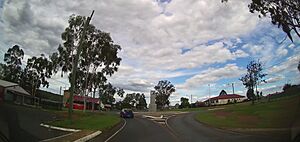Cherbourg, Queensland facts for kids
Quick facts for kids CherbourgQueensland |
|||||||||||||||
|---|---|---|---|---|---|---|---|---|---|---|---|---|---|---|---|

George of Saxby Downs with his wife at Barambah Aboriginal Settlement, 1909
|
|||||||||||||||
| Population | 1,194 (2021 census) | ||||||||||||||
| • Density | 37.55/km2 (97.3/sq mi) | ||||||||||||||
| Established | 1900 | ||||||||||||||
| Postcode(s) | 4605 | ||||||||||||||
| Elevation | 310 m (1,017 ft) | ||||||||||||||
| Area | 31.8 km2 (12.3 sq mi) | ||||||||||||||
| Time zone | AEST (UTC+10:00) | ||||||||||||||
| Location | |||||||||||||||
| LGA(s) | Aboriginal Shire of Cherbourg | ||||||||||||||
| State electorate(s) | Nanango | ||||||||||||||
| Federal Division(s) | Wide Bay | ||||||||||||||
|
|||||||||||||||
Cherbourg (/ˈʃɜːbɜːɡ/), formerly known as Barambah, Barambah Aboriginal Settlement and Cherbourg Aboriginal Settlement, is a rural town and locality in the Aboriginal Shire of Cherbourg, Queensland, Australia.
In the 2021 census, the locality of Cherbourg had a population of 1,194 people, of whom 1,151 (96.4%) identified as Indigenous Australians.
Contents
Geography
Cherbourg is located off the Bunya Highway approximately 250 kilometres (155 mi) north-west of Brisbane and 6 kilometres (3.7 mi) from the town of Murgon. It is situated on Barambah Creek, close to Bjelke-Petersen Dam.
History
In 1900, the Salvation Army negotiated for the establishment of the Barambah Aboriginal Reserve, which was gazetted over 7,000 acres (2,800 ha) on 23 February 1901. It was initially populated with a few local Aborigines, but others from the Esk region were soon sent to the reserve. Many were forcibly removed from their homes and "settled" at Barambah which was later renamed 'Cherbourg'. Sometimes they were sent there as punishment for refusing to work. People from 109 different areas were mixed together and they were not allowed to speak their own languages.
The reserve was administered by the Aboriginal Protection Society, Ipswich, until February 1905, when control passed to the Government of Queensland and a Superintendent was appointed, who reported to the Chief Protector of Aborigines. On 8 December 1931 the settlement was renamed Cherbourg. From 1905 until 1939, in total 1587 Indigenous people were removed to the settlement from all across the state.
The settlement housed a reformatory school and training farm, a home training centre for girls, a hospital, dormitories in which the women and children lived, and churches of various denominations. Training was provided in a variety of agricultural, industrial and domestic fields. People were hired out as cheap labour and at one stage they were not allowed to leave the reserve. In fact, until the referendum in 1967, the indigenous people at Cherbourg were not even counted in the census.
Cherbourg Post Office opened on 15 November 1965 and closed in 1986.
The effect of mixing these different groups of people together and forcing them to learn to speak a foreign language (English) has been an almost total loss of their cultural heritage. Many of the languages are considered to be extinct, surviving only in notes and recordings stored at the University of Queensland.
Demographics
In the 2006 census, the town of Cherbourg had a population of 1,128.
In the 2016 census, the locality of Cherbourg had a population of 1,269 people, of whom 98.7% identified as Indigenous Australians.
In the 2021 census, the locality of Cherbourg had a population of 1,194 people, of whom 1,151 (96.4%) identified as Indigenous Australians.
Education
Cherbourg State School is a government primary (Early Childhood-6) school for boys and girls at Fisher Street (26°17′34″S 151°57′18″E / 26.2929°S 151.9551°E). In 2018, the school had an enrolment of 130 students with 17 teachers and 40 non-teaching staff (25 full-time equivalent). It includes a special education program.
Cherbourg is home to the Nurunderi (meaning taught by Great Spirit) campus of TAFE Queensland South West (26°17′42″S 151°57′23″E / 26.2951°S 151.9565°E). It offers general courses of study as well as ones specific to Aboriginal and Torres Strait Islanders. All people are welcome to study at this campus.
There is no secondary school in Cherbourg. The nearest government secondary school is Murgon State High School in neighbouring Murgon to the north.
Information and emergency services
The Cherbourg Aboriginal Shire Council operates the Winifred Fisher Knowledge Centre in the Old Youth Respite Centre, Barambah Road.
Other facilities include:
- Cherbourg Police Station (26°17′25″S 151°57′22″E / 26.2902°S 151.9562°E)
- Cherbourg Fire Station (26°17′21″S 151°57′24″E / 26.2891°S 151.9567°E)
- Cherbourg SES Facility (26°17′16″S 151°57′24″E / 26.2878°S 151.9566°E)
- Cherbourg Hospital & Community Health Centre (26°17′30″S 151°57′25″E / 26.2916°S 151.9569°E) with heliport (26°17′28″S 151°57′27″E / 26.2912°S 151.9574°E)
- Winifred Fisher Indigenous Knowledge Centre
Notable people
- Caroline Archer – activist for Aboriginal culture and rights
- Maroochy Barambah – opera singer
- Adrian Blair – Olympic boxer
- Harold Blair – tenor and activist
- Selwyn Cobbo – NRL rugby league player born in Cherbourg
- Marlene Cummins – musician and activist
- Frank Fisher – Rugby League player
- Lionel Fogarty – poet and political activist
- Eddie Gilbert – cricket player
- Ruth Hegarty – author
- Albert Henry – cricketer
- Jerry Jerome – boxer
- Chris Sandow – NRL rugby league player
- Chris Sarra – Indigenous educator
- Willie Tonga – Australia and Queensland representative rugby league player
- Daniel Alfred Yock – dancer
See also
 In Spanish: Cherbourg (Australia) para niños
In Spanish: Cherbourg (Australia) para niños



